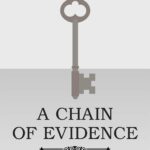
The Gold Bag by Carolyn Wells
Author: Carolyn Wells
Published: 1911
Genre: Mystery
Read The Gold Bag online at PageVio
The Gold Bag is a novel by Carolyn Wells, published in 1911 and part of the Fleming Stone mysteries.
1. The Gold Bag Synopsis
In The Gold Bag, a young and astute detective is thrust into the shadowy corners of West Sedgwick to solve the enigmatic murder of prominent businessman Joseph Crawford. Amidst a tangle of clues, including a mysterious newspaper and a telling trolley transfer, the detective’s path crosses with the formidable Miss Florence Lloyd, whose regal bearing and contradictory nature hint at hidden depths. As he meticulously pieces together the puzzle, he grapples not just with the intricacies of the crime but also with the complexities of human nature and secrecy.
2. The Gold Bag Summary
Chapter 1: The Crime in West Sedgwick
The story begins with the narrator, a young but experienced detective named Burroughs, reflecting on his methodical and systematic approach to solving cases. He contrasts his style with that of another detective, Fleming Stone, who has an almost clairvoyant ability to deduce facts from minor details. Burroughs recalls a morning encounter with Stone, where Stone impressively deduces intricate details about a person’s life just by observing a pair of shoes. Later, Burroughs receives an urgent call from the Detective Bureau, instructing him to investigate a murder in West Sedgwick. The victim is Joseph Crawford, a prominent figure both in business and in the town. Burroughs catches a train to West Sedgwick, determined to solve the case.
Chapter 2: The Crawford House
Upon arriving in West Sedgwick, Burroughs is struck by the town’s affluence. He learns from the coachman who picks him up that Mr. Crawford was highly respected and seemed to have no enemies. Burroughs then arrives at the Crawford house, where he meets the coroner, Mr. Monroe, and another detective, Mr. Parmalee. Parmalee shares his belief that the murder suspect is already known but remains unnamed until the inquest. Burroughs is shown to Mr. Crawford’s office, where he observes the crime scene and notes a gold-mesh purse, which Parmalee suggests belongs to Florence Lloyd, Mr. Crawford’s niece and housekeeper. Parmalee implies that she might be involved in the murder due to her engagement to Mr. Crawford’s secretary, Gregory Hall, which the victim did not approve of.
Chapter 3: The Coroner’s Jury
During the coroner’s jury, Burroughs discreetly investigates the crime scene. He pays little attention to the jurors’ individual reactions, focusing instead on examining the room and its contents. He finds a newspaper and a trolley transfer slip, both potentially significant evidence. The jurors include Horace Hamilton and Lemuel Porter, friends of the deceased. Another juror, Mr. Orville, shows a keen interest in the investigation, but his suggestions are deemed irrelevant by Burroughs. After the jury leaves, Burroughs discusses the case with Parmalee and Monroe, learning about the household members and Gregory Hall, the secretary and fiance of Florence Lloyd.
Chapter 4: The Inquest
Returning for the inquest, Burroughs observes the attendees, focusing on Florence Lloyd. He describes her as a powerful, imposing figure with a contradictory demeanor, blending haughtiness with gentleness. Despite not having any evidence against her, Burroughs feels an instinctual suspicion towards her. He finds her fascinating and complex, dressed in mourning attire that complements her regal demeanor.
Chapter 5: Florence Lloyd
Florence Lloyd is called to testify at the inquest into her uncle’s death. She calmly answers questions about her relationship with her uncle and her engagement to Gregory Hall, which her uncle opposed. Florence reveals that her uncle threatened to disinherit her if she didn’t end her engagement. Despite the discomfort of the situation, Florence remains composed and insists on telling the truth to aid the investigation. The chapter showcases the tension between personal affairs and the pursuit of justice.
Chapter 6: The Gold Bag
The gold bag becomes a critical piece of evidence during the investigation. When confronted with the bag, Florence Lloyd, the niece of the deceased, denies it’s hers, despite matching details such as the glove size found within. Her denial and the following investigation raise suspicions, especially from Detective Parmalee. The maid, Elsa, also denies the bag belongs to Florence, but her statements seem dubious and rehearsed. The detectives suspect collusion between Florence and Elsa. Despite the growing evidence, some, like Philip Crawford and the jurors Hamilton and Porter, remain sympathetic towards Florence.
Chapter 7: Yellow Roses
The focus shifts to a bunch of yellow roses sent to Florence by Gregory Hall, her fiancé. These roses become significant when two petals are found at the crime scene. Florence’s behavior and responses during the interrogation raise further suspicions. She faints under the pressure of questioning, indicating either genuine distress or a tactic to avoid scrutiny. The investigators and jurors start to debate whether the gold bag and the rose petals directly implicate Florence in the crime or are merely circumstantial evidence.
Chapter 8: Further Inquiry
The chapter delves deeper into the night of the murder, revealing that Mr. Crawford had an argument with Florence about her relationship with Gregory Hall and threatened to disinherit her. This revelation adds a possible motive for Florence’s involvement in the murder. The detectives also learn about Florence’s activities on the night of the murder, which do not conclusively prove her innocence or guilt. The coroner and other officials start to feel the pressure of the case, especially when the lack of a weapon and other missing evidence are considered.
Chapter 9: The Twelfth Rose
Following the funeral, the Crawford household remains in a state of mourning. Gregory Hall, who is set to inherit a fortune through his engagement to Florence, becomes a person of interest due to his potential motive. The investigators start to question the whereabouts and actions of Gregory Hall on the night of the murder, but he remains uncooperative and evasive. The chapter ends with the detectives resolving to continue the investigation, focusing on every clue and piece of evidence, regardless of where it leads.
Chapter 10: The Will
The focus shifts to the mysterious disappearance of Mr. Crawford’s will. Gregory Hall, the secretary and fiancé of Florence Lloyd, is distressed over the missing will. If the will isn’t found, Florence, not being a direct relative of the Crawfords, stands to inherit nothing, potentially making her uncle’s brother, Philip Crawford, the legal heir. During Mr. Crawford’s funeral, the attendees, especially Florence, show varied reactions, with Florence appearing particularly affected. The revelation of the missing will shock everyone. A photograph found in Mr. Crawford’s office suggests a woman named Purvis might be involved in the case. The chapter ends with the narrator’s increasing distrust and dislike for Gregory Hall, who seems more concerned with the fortune than the tragedy of Mr. Crawford’s death or Florence’s well-being.
Chapter 11: Louis’s Story
The chapter begins with the detective’s attempt to trace a trolley transfer, which he believes could link Gregory Hall to the crime. However, he learns that the transfer is not a definitive clue. The detective then has a conversation with Miss Lloyd, where he expresses his suspicion that Louis, Mr. Crawford’s valet, did not tell the whole truth at the inquest. Miss Lloyd is visibly agitated by this suggestion. When Louis is questioned, he nervously admits to having the transfer on him the night of the murder, but denies going near Mr. Crawford’s office. Miss Lloyd and Louis both seem to be hiding something, raising further suspicion about their involvement or knowledge of the crime.
Chapter 12: Louis’s Confession
After questioning the maid Elsa, the detective learns that Louis wore a yellow rose the night of the murder, contradicting his earlier testimony. Despite his initial denials, Louis eventually admits to seeing Miss Lloyd in the office with her uncle that night, a fact she had previously denied. This revelation is significant, as it contradicts Miss Lloyd’s testimony at the inquest and implies she knows more about the murder than she has revealed.
Chapter 13: Miss Lloyd’s Confidence
The detective is convinced that Florence Lloyd is withholding information about her uncle’s murder. Although she initially denies being in the office with her uncle, the evidence from Louis suggests otherwise. The chapter delves into the detective’s internal struggle as he grapples with his growing feelings for Miss Lloyd, despite the mounting evidence against her. The detective’s conversation with Parmalee further complicates matters, as Parmalee suggests that Miss Lloyd might be more deeply involved in the murder than initially thought, possibly as the instigator or even the perpetrator.
Chapter 14: Mr. Porter’s Views
Detective Burroughs continues to grapple with the complexities of the case. He confronts Florence Lloyd about her earlier untruth regarding her whereabouts on the night of the murder. She admits to lying out of fear of being implicated in her uncle’s death. Florence insists that the mysterious gold bag found at the crime scene is not hers, despite the detective’s suspicions. This admission, along with Florence’s hesitance when asked about Gregory Hall’s involvement, leads Burroughs to suspect collusion between Florence and Gregory. Despite these suspicions, he remains determined to protect them, especially Florence, whom he has developed feelings for. The chapter closes with Burroughs meeting Mr. Porter, who downplays the significance of the gold bag but acknowledges the possibility of a female visitor being involved in the crime.
Chapter 15: The Photograph Explained
Burroughs visits Philip Crawford, the brother of the deceased and a key figure in the inheritance issue. Philip Crawford dismisses the idea that the gold bag is a crucial clue and expresses his belief that Florence might disown her property out of fear. He firmly believes in Florence’s innocence and is skeptical about any theory involving Gregory Hall. A discussion about a photograph found in Mr. Crawford’s desk leads to the revelation that it is a harmless memento, unrelated to the case. Philip Crawford, despite his relationship with his brother, is unable to shed light on any potential enemies or motives for the murder. The chapter concludes with Philip Crawford’s son offering a robust defense of Florence and Hall, easing some of the detective’s apprehensions and reviving his determination to solve the case.
Chapter 16: A Call on Mrs. Purvis
The detective visits Mrs. Egerton Purvis in New York City to inquire about a gold-mesh bag linked to the murder case. Mrs. Purvis denies owning the bag but recalls giving her card to a lady who had such a bag. After checking her records, she identifies the lady as Mrs. Cunningham of Marathon Park, New Jersey. The detective considers this lead significant and plans to follow up.
Chapter 17: The Owner of the Gold Bag
Mrs. Cunningham, the owner of the gold bag, contacts the detective, admitting she lost the bag but denying any involvement in the murder. She explains that she left the bag on a train the night of the murder. Her story seems credible, and she agrees to explain everything to Florence Lloyd. The detective, still suspicious of Gregory Hall, plans to further investigate Hall’s actions on the night of the murder.
Chapter 18: In Mr. Goodrich’s Office
The detective shares the latest developments with the district attorney, Mr. Goodrich, and Mr. Porter. Despite new information pointing away from Florence Lloyd, the district attorney believes both Florence and Gregory Hall remain prime suspects. The detective remains conflicted due to his feelings for Florence and considers seeking help from a famous detective, Fleming Stone. However, he resolves to continue his investigation, focusing on Hall’s possible guilt and the mysterious events on the night of the murder.
Chapter 19: The Midnight Train
Florence Lloyd and Mr. Porter discuss Gregory Hall’s arrest with the detective. They express doubts about Hall’s guilt, with Porter suggesting that an unknown stranger from outside town might be the real murderer. The detective is advised to force Hall to reveal his alibi for the night of the murder, but he is uncertain if Hall will divulge this information. The detective feels that Hall’s refusal to disclose his whereabouts is not indicative of guilt but rather a desire to protect a private matter.
Chapter 20: Fleming Stone
Fleming Stone, a renowned detective, is brought in to solve the case at Florence’s request. Detective Burroughs recounts his encounter with Stone in New York and their discussions about the murder. Stone examines Hall’s demeanor and finds it too unconcerned for a guilty person. They visit Hall in custody, where Stone cleverly deduces that Hall was in Brooklyn the night of the murder, with another woman, proving his innocence. Hall reluctantly admits the truth of Stone’s deduction but pleads that his night in Brooklyn remains a secret, especially from Florence. The chapter ends with Hall’s release from custody, but the real murderer remains unknown.
Chapter 21: The Disclosure
Stone theorizes that Joseph Crawford’s murder was committed by someone known to him, during the window of time between Florence Lloyd and Philip Crawford’s visits. He deduces that the murderer must have been someone desperate about financial matters related to stocks, which Joseph Crawford had influence over.
Suddenly, Stone confronts Lemuel Porter, a friend and neighbor of the deceased, accusing him of the murder. Porter, shocked and cornered, confesses to the crime. He admits he killed Joseph Crawford in a moment of blind rage induced by financial desperation. Porter had overtraded in the stock market and feared ruin if Crawford didn’t act in a way that would save him. During their meeting, Porter saw Crawford’s pistol and, in a moment of impulse, shot him.
Porter, realizing the gravity of his actions and the inevitable consequences, takes poison in front of everyone and dies. This act brings the investigation to a tragic yet conclusive end.
The story concludes with the detective reflecting on his role in the case and his personal feelings for Florence Lloyd. Florence, now free from her engagement to Gregory Hall, admits her feelings for the detective. The story ends on a hopeful note for their budding relationship.




